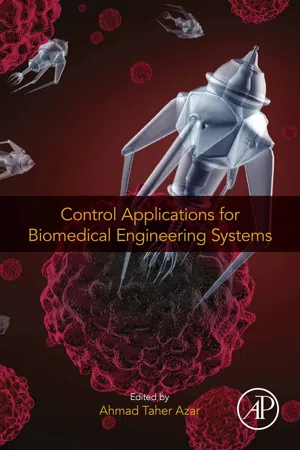
This is a test
- 476 pages
- English
- ePUB (mobile friendly)
- Available on iOS & Android
eBook - ePub
Control Applications for Biomedical Engineering Systems
Book details
Book preview
Table of contents
Citations
About This Book
Control Applications for Biomedical Engineering Systems presents different control engineering and modeling applications in the biomedical field. It is intended for senior undergraduate or graduate students in both control engineering and biomedical engineering programs. For control engineering students, it presents the application of various techniques already learned in theoretical lectures in the biomedical arena. For biomedical engineering students, it presents solutions to various problems in the field using methods commonly used by control engineers.
- Points out theoretical and practical issues to biomedical control systems
- Brings together solutions developed under different settings with specific attention to the validation of these tools in biomedical settings using real-life datasets and experiments
- Presents significant case studies on devices and applications
Frequently asked questions
At the moment all of our mobile-responsive ePub books are available to download via the app. Most of our PDFs are also available to download and we're working on making the final remaining ones downloadable now. Learn more here.
Both plans give you full access to the library and all of Perlego’s features. The only differences are the price and subscription period: With the annual plan you’ll save around 30% compared to 12 months on the monthly plan.
We are an online textbook subscription service, where you can get access to an entire online library for less than the price of a single book per month. With over 1 million books across 1000+ topics, we’ve got you covered! Learn more here.
Look out for the read-aloud symbol on your next book to see if you can listen to it. The read-aloud tool reads text aloud for you, highlighting the text as it is being read. You can pause it, speed it up and slow it down. Learn more here.
Yes, you can access Control Applications for Biomedical Engineering Systems by Ahmad Taher Azar in PDF and/or ePUB format, as well as other popular books in Computer Science & Data Modelling & Design. We have over one million books available in our catalogue for you to explore.
Information
1
Neuro-fuzzy inverse optimal control incorporating a multistep predictor as applied to T1DM patients
Alma Y. Alanisa; Y.Yuliana Riosd; J.A. García-Rodrígueza; Edgar N. Sanchezb; E. Ruiz-Velázqueza; Aldo Pardo Garciac a Electronics and Computing Division, CUCEI, Universidad de Guadalajara, Guadalajara, Mexico
b Electrical Engineering Department, CINVESTAV, Zapopan, Mexico
c A&C, Automation and Control Group, Universidad de Pamplona, Pamplona, Colombia
d GAICO, Grupo de Automatización y Control, Universidad Tecnológica de Bolívar, Cartagena, Bolívar, Colombia
b Electrical Engineering Department, CINVESTAV, Zapopan, Mexico
c A&C, Automation and Control Group, Universidad de Pamplona, Pamplona, Colombia
d GAICO, Grupo de Automatización y Control, Universidad Tecnológica de Bolívar, Cartagena, Bolívar, Colombia
Abstract
Emerging technologies seek to provide effective solutions to the most severe health problems such as type 1 diabetes mellitus (T1DM). In fact, the number of diabetics around the world has increased as well as the mortality rate associated with this condition. T1DM is caused by an autoimmune failure which disables the pancreas to produce insulin; therefore, glucose is not correctly metabolized to be used as efficient energy. Consequently, the most important fact is to keep the patient's blood glucose level within normal ranges in order to avoid long-term complications. Recently, engineering innovative approaches based on intelligent systems such as artificial neural networks have been proposed for control in biomedical systems. In this work, a novel neuro-fuzzy control scheme for blood glucose regulation in virtual T1DM patients is proposed. The glucose-insulin dynamics is modeled by a recurrent high-order neural network and then a neural multistep predictor is incorporated in order to know the glucose behavior within a 15-min horizon; thereby, allowing the knowledge of future values to determine the convenient basal infusion insulin rate as defined by the fuzzy membership functions. Test using the well-known Uva/Padova simulator illustrated that the propos...
Table of contents
- Cover image
- Title page
- Table of Contents
- Copyright
- Contributors
- Foreword
- Preface
- 1: Neuro-fuzzy inverse optimal control incorporating a multistep predictor as applied to T1DM patients
- 2: Blood glucose regulation in patients with type 1 diabetes by means of output-feedback sliding mode control
- 3: Impulsive MPC schemes for biomedical processes: Application to type 1 diabetes
- 4: Robust control applications in biomedical engineering: Control of depth of hypnosis
- 5: Robust control strategy for HBV treatment: Considering parametric and nonparametric uncertainties
- 6: A closed loop robust control system for electrosurgical generators
- 7: Application of a T-S unknown input observer for studying sitting control for people living with spinal cord injury
- 8: Epidemic modeling and control of HIV/AIDS dynamics in populations under external interactions: A worldwide challenge
- 9: Reinforcement learning-based control of drug dosing with applications to anesthesia and cancer therapy
- 10: Control strategies in general anesthesia administration
- 11: Computational modeling of the control mechanisms involved in the respiratory system
- 12: Intelligent decision support for lung ventilation
- 13: Customized modeling and optimal control of superovulation stage in in vitro fertilization (IVF) treatment
- 14: Models based on cellular automata for the analysis of biomedical systems
- Index